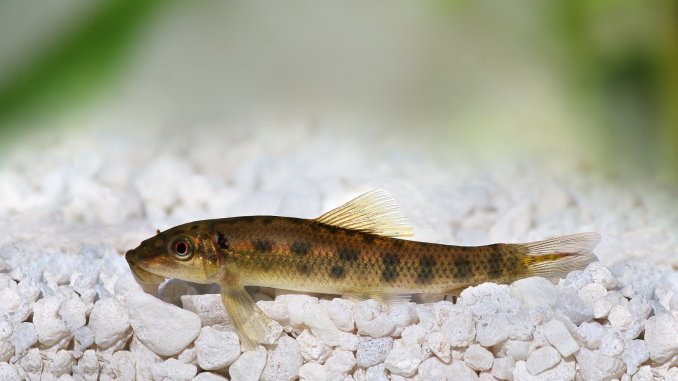
The Chinese algae eater is a freshwater species of algae eater of the Gyrinocheilidae family.
Chinese algae eaters have an unimpressive appearance, with long, brown bodies that blend into the substrate. These bottom-dwelling fish are solitary creatures that spend most of their time eating algae from the tank.
Chinese algae eaters are popular due to their tank-cleaning abilities.
TABLE OF CONTENTS
Chinese Algae Eater Facts & Overview
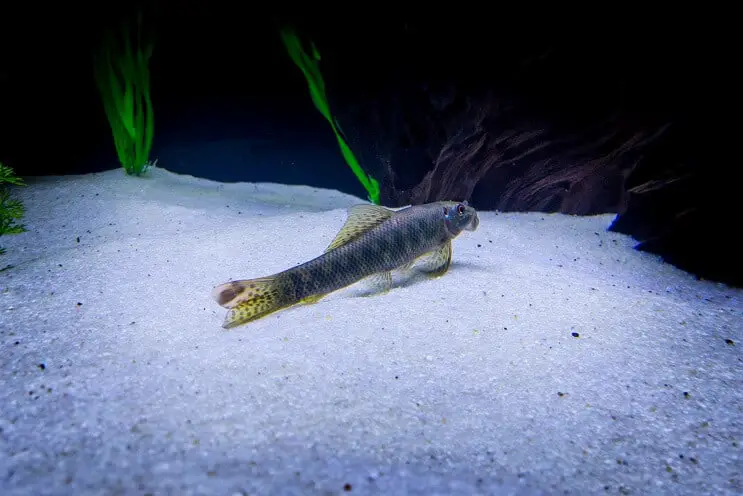
| Scientific name: | Gyrinocheilus aymonieri |
| Common names: | Chinese algae eater, sucking loach, honey sucker |
| Distribution: | Laos, Vietnam, Thailand |
| Size: | 5–7 inches |
| Life expectancy: | 7–10 years |
| Color: | Pale brown with black stripes or spots |
| Diet: | Herbivore |
| Temperament: | Semi-aggressive |
| Minimum tank size: | 50 gallons |
| Temperature: | 72–82°F (22–28°C) |
| pH: | 6.8–7.4 |
| Hardness: | 5–19 dGH |
| Care level: | Easy |
| Breeding: | Egg layer |
Origin
The natural habitat of a Chinese algae eater is warm lakes and fast-flowing rivers with sandy substrate, vegetation, and driftwood. In rainy seasons, this habitat becomes flooded and muddy.
Despite their name, Chinese algae eaters aren’t commonly found in China. The fish is predominantly found in other parts of Asia, including the Chao Phraya basin in Thailand, and tropical streams and rivers in Thailand, Vietnam, and Laos.
Chinese algae eaters swim close to the bottom of the river bed to avoid being pulled downstream. The fish use their suckermouths to anchor onto rocks and driftwood, and during feeding, the fish use two specialized organs to force water across their gills to help with respiration.
Adult Size & Lifespan
Fully-grown Chinese algae eaters grow up to 11 inches long in the wild. In captivity, these fish grow to five to seven inches in length. Males and females grow to similar lengths, but females are wider than males.
The average lifespan of a Chinese algae eater is five to ten years.
Availability
Chinese algae eaters are usually available at most aquarium stores due to this species’ usefulness as tank cleaners. However, these fish aren’t as commonly available as colorful tropical fish.
The typical cost of a Chinese algae eater is $4–$6 per fish. You can find Chinese algae eaters on most online fish stores, including:
- LiveAquaria, which sells Chinese algae eaters and gold algae eaters (yellow-colored fish from the Chinese algae eater family).
- The Wet Spot, which sells reticulated Chinese algae eaters.
Appearance & Behavior
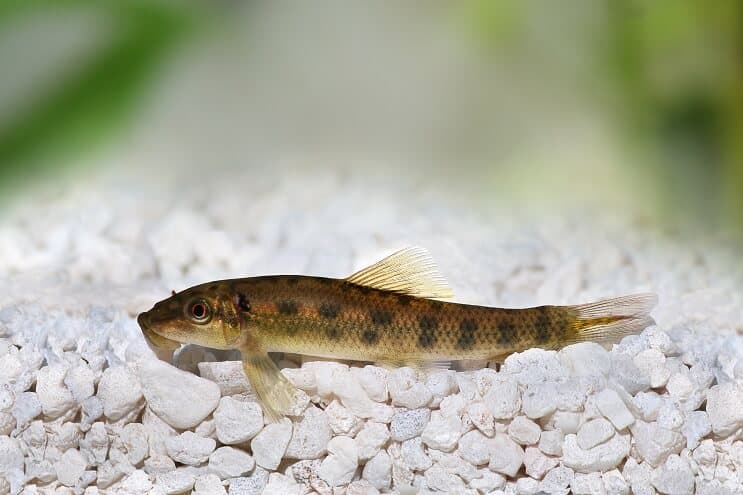
Chinese algae eaters keep to themselves and have aggressive tendencies toward similarly-sized fish. Chinese algae eaters have elongated brown bodies, small fins, and suckermouths.
Colors, Patterns, Fins, and Sex Differences
Chinese algae eaters are dull fish with light-brown bodies and short, semi-transparent fins. Some Chinese algae eaters have a horizontal black stripe that spans from the fish’s head to tail. Other Chinese algae eaters have black spots, and some fish have a mixture of spots and stripes.
The most notable feature of the Chinese algae eater is its protruding suckermouth, which the fish uses to latch onto objects when feeding.
There are several color variations of the Chinese algae eater, including:
- Albino Chinese algae eaters, which have pale yellow bodies and golden eyes
- Gold Chinese algae eaters, which have dark yellow bodies
Male Chinese algae eaters develop tubercles or “horns” on their noses when mating, while females don’t. Female Chinese algae eaters are plumper than males. Chinese algae eaters become duller than usual when stressed.
Typical Behavior
Chinese algae eaters are solitary, non-schooling fish with semi-aggressive tendencies. These fish will fight fish of a similar size, including other Chinese algae eaters, if housed together in captivity.
When housed with peaceful, compatible fish, Chinese algae eaters spend most of their time swimming along the bottom of the tank, scavenging the substrate for food. Once a Chinese algae eater has latched onto a surface in the tank — such as a rock or the glass tank sides — the fish will remain there for hours.
These fish are primarily nocturnal, so the fish are most active during the night, and spend daylight hours resting in caves or behind plants.
Chinese Algae Eater Care & Tank Requirements
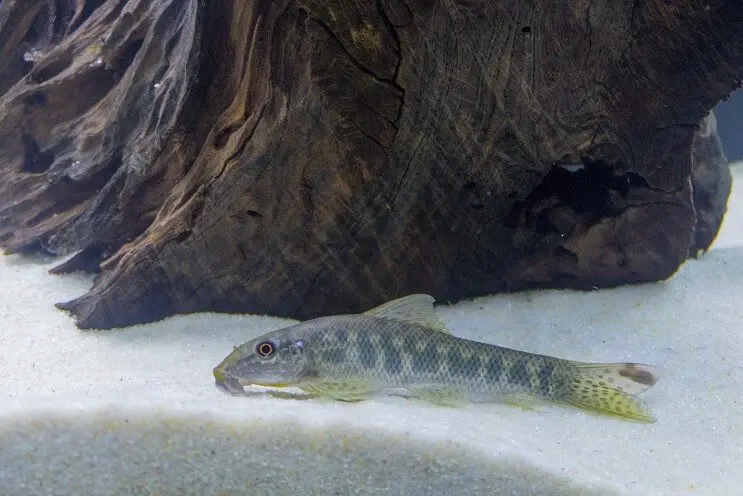
Chinese algae eaters are easy to care for. The fish are hardy, but tank conditions should mimic the Chinese algae eater’s environment to prevent stress and disease.
Chinese algae eaters follow a largely herbivorous diet that should be replicated in captivity.
Habitat and Tank Requirements
In the wild, Chinese algae eaters live in warm, fast-flowing rivers and streams in Asia. The fish swim along the sandy, stony riverbed, latching onto surfaces to feed and to prevent themselves from being pulled along by the current. Chinese algae eaters seasonally migrate to flooded areas with muddy waters.
Mimic the Chinese algae eater’s natural habitat in the tank with the right choice of substrate and decorations and optimal water conditions.
Chinese algae eaters require a large tank of at least 50 gallons. Choose a rectangular tank with more width than height to provide plenty of exploring room for bottom-dwelling Chinese algae eaters.
Sand or gravel is a good choice for substrate in a Chinese algae eater’s tank because it replicates the sandy riverbed in the wild. Sand is the best option because it’s less likely than gravel to scratch the fish.
Caves and rocks provide a place for Chinese algae eaters to retreat to when stressed or resting. Giving the Chinese algae eater its own territory will prevent stress and territorial behavior in the tank.
Live plants offer additional shelter and help keep the tank clean. The best plants to use in a Chinese algae eater tank are deep-rooted plants like anubias and Java fern. You can also add fake plants made from silk or plastic to the tank to provide extra surfaces for growing algae, which Chinese algae eaters eat.
Tank Conditions
The ideal tank conditions for Chinese algae eaters are:
| Water type: | Moderately soft, fast-flowing freshwater |
| Tank size: | Minimum 50 gallons, plus 50 gallons per extra fish |
| Water temperature: | 72–82°F |
| Substrate: | Sand or fine gravel |
| Tank setup: | Caves, plants, hollow decorations |
| Acidity: | 6.8–7.4 pH |
| Water hardness: | 5–19 dGH |
| Filter: | Yes, to provide a good current and to keep the tank clean |
| Pump: | Not essential, but can be used to make the current stronger |
| Bubbler: | No |
| Lighting: | Yes, standard aquarium lighting to mimic the natural day-to-night cycle and encourage plant growth |
| Water heater: | Yes, to maintain the required water temperature range for these tropical fish |
The most important aspect of caring for a Chinese algae eater is to keep the tank clean. Chinese algae eaters are sensitive to nitrates in the water, so you should monitor nitrate levels with testing kits and perform regular water changes to keep nitrate levels as close to 0 ppm as possible.
Disease
There are no diseases that are specific to Chinese algae eaters, but the fish can contract common freshwater aquarium diseases.
Ich
Ich, or white spot disease, is a disease caused by the parasite Ichthyophthirius multifiliis, which usually occurs due to poor water conditions. Fish with Ich have white, salt-like sprinkles on their bodies, and appear lethargic and inactive. The fish will scratch their bodies against rough surfaces in the tank.
To treat Ich, quarantine the affected fish by adding one tablespoon of salt per five gallons of water in the tank. Increase the water temperature by two degrees to speed up the lifecycle of the parasite.
Bloating
Overfeeding Chinese algae eaters leads to bloating. Bloating can be a sign of dropsy, which occurs when fluid builds up inside the fish’s tissues or body cavity. Bloating is also caused by constipation resulting from poor nutrition.
Treat a fish with dropsy by changing 25% of the water in the tank every two days for two weeks. Treat bloating caused by constipation by reducing the amount of food fed to the fish.
Tank Mates
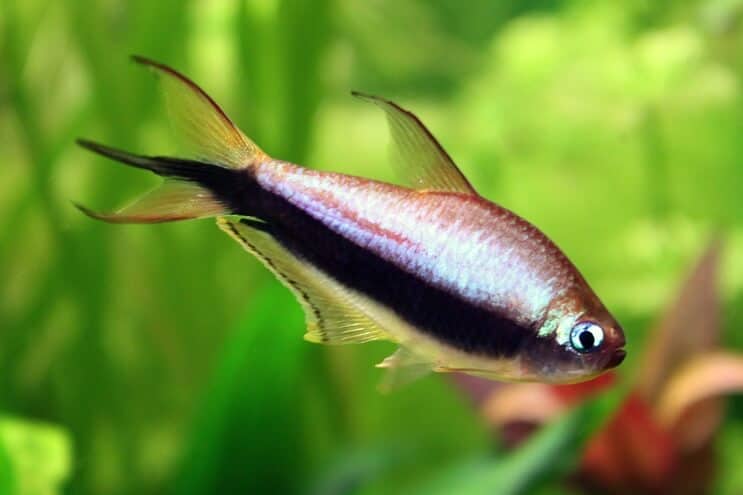
Chinese algae eaters have aggressive tendencies that limit the types of fish that can serve as tank mates.
Avoid housing Chinese algae eaters with fish that are similar in size or appearance to Chinese algae eaters, or fish that swim in the bottom of the tank. Fish with flat bodies should also be avoided because Chinese algae eaters often attach onto these fish with their mouths.
The best tank mates for Chinese algae eaters are small, speedy fish that occupy the upper levels of the tank, such as:
- Mollies
- Platies
- Tiger barbs
- Clown loaches
- Cherry barbs
- Emperor tetras
- Dwarf gouramis
- Swordtails
- Zebra danios
Don’t house Chinese algae eaters together unless you have a large tank with at least 50 gallons per fish.
Diet and Feeding
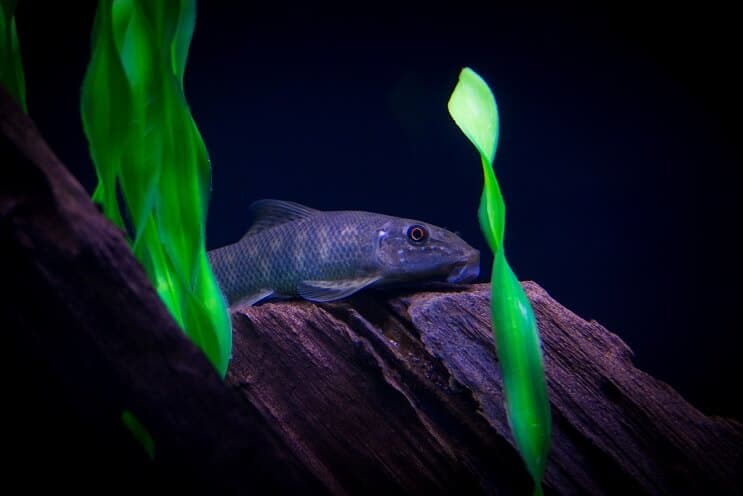
In the wild, Chinese algae eaters feed on algae, which the fish scrape from rocks and plants using their sucker mouths. Although the Chinese algae eater’s diet is composed mostly of plants, the fish also eats protein sources such as maggots.
Chinese algae eaters exhibit similar algae-eating behavior in captivity, latching onto the walls and tank decorations to scrape off algae. If there isn’t enough algae in your tank, supplement the fish’s diet with algae wafers. Green vegetables like blanched spinach and lettuce can also be provided as plant-based food sources.
Good protein sources for Chinese algae eaters are daphnia, bloodworms, and brine shrimp. Provide at least one source of protein per week.
A set feeding schedule isn’t necessary for Chinese algae eaters because the fish should get enough food from algae, leftover food from other fish, and the occasional supplementary algae wafer or protein source.
Check that the tank has enough algae for the fish to eat, and provide a pinch of supplementary food several times per week.
Breeding
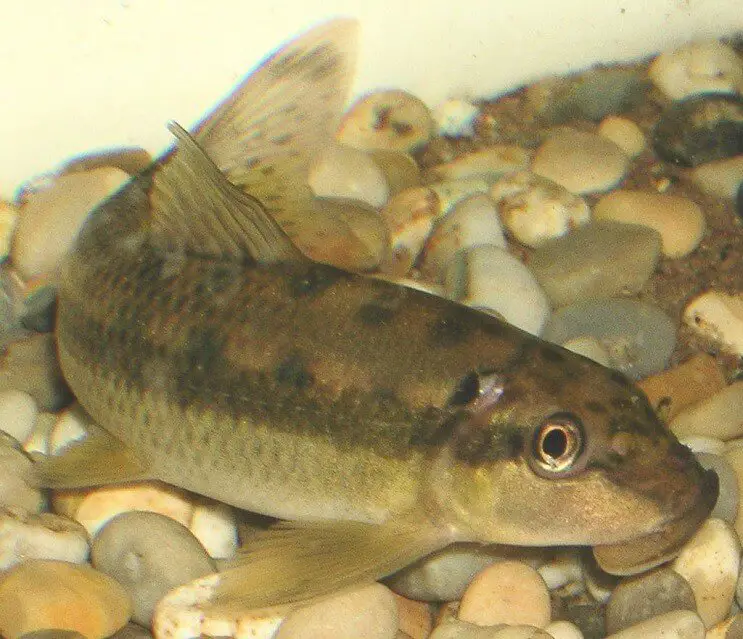
Breeding Chinese algae eaters is difficult, and there are no established breeding methods for these fish. Most fish hatcheries use hormonal agents to breed Chinese algae eaters, which you won’t have access to in a home breeding setup.
Only experienced fishkeepers should attempt to breed these fish in captivity.
Chinese algae eaters reach sexual maturity at three years old. To breed Chinese algae eaters, prepare for trial and error and follow the instructions below:
- Establish a separate breeding tank of at least 100 gallons, with dim lighting, filled with lots of vegetation, and with good filtration and a strong water flow.
- Choose a healthy male and a healthy female and place the fish in the breeding tank. Increase water temperature by two or three degrees per day until you reach a temperature of 82°F to trigger spawning.
- Feed the fish a highly nutritious diet of live or frozen food. Make sure water parameters are maintained precisely and that water is clean. Carry out daily 10% water changes.
- At this point, in a professional breeding setup, the female would receive two hormonal injections. Without hormonal interference, you should wait for several weeks to see if the female is interested in spawning.
- An interested female will lay up to 3,000 eggs on the walls of the tank and the leaves of the plants for the male to fertilize. If the female shows no interest within a month, or the pair begins to fight or show signs of aggression, remove the female and try with another female.
- Remove the fish from the tank and return them to their home tanks after the male has fertilized the eggs, to prevent the parents from eating the fry.
- Continue to provide daily water changes. The fry should hatch within three days.
- Feed the fry a diet of algae until the fish are ready to be moved to their own separate tanks – usually within two to three months.
Should You Get a Chinese Algae Eater for Your Aquarium?
Chinese algae eaters are useful, hardy fish that are suitable for beginners and experienced aquarists.
You should consider a Chinese algae eater for your tank if you have plenty of space for this bottom-dwelling species. Don’t buy a Chinese algae eater if your tank contains fish of a similar size or appearance to the Chinese algae eater, which could provoke aggression and territorial behavior.
Thanks to their tank cleaning abilities, Chinese algae eaters play a big part in algae control and reduce your cleaning responsibilities. Despite their unimpressive appearance, Chinese algae eater fish are a quirky, entertaining addition to a home aquarium.

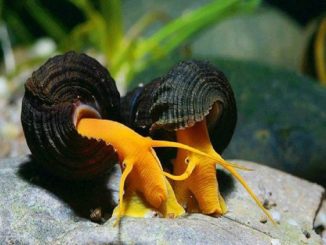
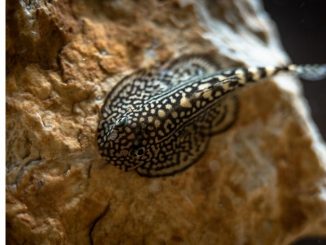
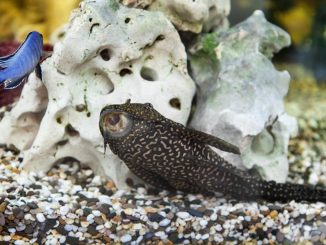
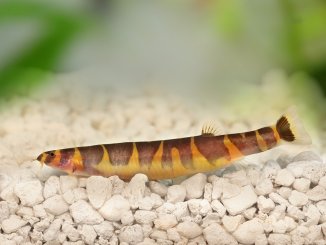
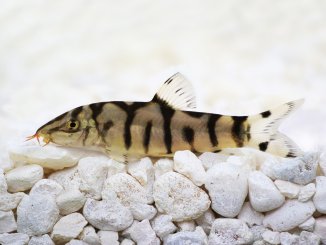
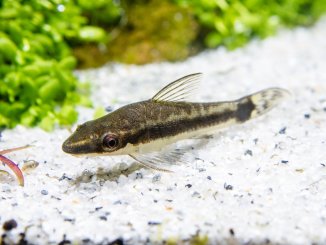
DO NOT GET A DWARF GOURAMI WITH A CAE. I have a blue powder dwarf gourami with a common pleco and a RES turtle. One day I saw the tiny baby Chinese algae eaters and I thought one would be great since I have such a lazy pleco. Once he got bigger, he sucked the slime coat of my dwarf gourami and he had a horrific fungus infection resulting from it on both sides of his body. After a week of salt baths twice a day and lifeguard treatments in newly changed water daily he healed. It was so rough and took up a couple hours everyday. He is now very happy with the turtle and pleco in a 75 gal. Needless to say the CAE is in a separate tank now alone with snails and I seriously regret buying it. Dwarf gouramis are terrible tank mates for this fish. The pleco was not harassed. Gouramis have better luck with turtles than CAE.
It came with a group of other fish but it looms great anyway so I kept it
I have I Chinese algae eater. I had I bit of a scare when I first put other fish in with him as he started eating their slime coats, but when I put him in a smaller tank for a while and then put him back in his original tank, and now he is fine and happy.
I have one that I will rehome as it just started chasing my angels. I got it when it was tiny, and it does a great job with algae. It is VERY active and definitely needs more space than my 30g tank no that he’s almost 4 inches. I’m going to miss him, he’s hella good fun to watch.
Well I’m sorry to say my algae eater is in with african cichlids various & these fish are aggressive but yet the algae eatet gets on fine & chases other fish away but itvis amazimg as it never rests so sorry but ive never followed the guide & never had problems whatever works best for ur fish i suppose & i have 6 different breeds of catfish too so im happy tank been running years
I have a Chinese algae eater with a golden algae eater with a few snails And1 crowntail betta male fish and they are fine in the same tank a 10g
I have 3 cae’s, 2 golden and 1 regular. They are all around 6 or 7 inches long and are in a 75 gallon with around 25 mbuna and 5 haps. Tank has been set up over a year now and no problems.Very active fish and fit great with the African cichlids temperament
It was a gift from someone who breeds then. This one was fighting with the other female that appeared to have eggs.
I don’t like the noise if the air pump. Is that necessary? It’s a small 3 gal set up. This is the only fish.
I just now set up a 5gal glofish tank and was told this CAE was okay to put with my Tetra glofish,5 reg. Glofish and 2 fancy guppies. After only a few days of putting the CAE in the tank, 1 of my Tetras and both guppies disappeared. I’m figuring they had to be eaten by the CAE, since there was no sign of any of them.
My CAE is not eating. He wants to be glued to the filter under the water drop. The glasé ofrece the aquarium is full ofrece algae since my CAE desde this. The only chance I madera watts to remove all the decoración frontal the acuario to crean is. Can someone tell me why muy CAE doesn’t watts to eat?
I have one with Australian and Madagascar Rainbows, Zebra Danios, a Yoyo Loach, Cory Dora Catfish, and a Striped Rafael catfish with no difficulties. My only issue is that the YoYo loach (3 inches) likes to be nosey and chase the Chinese Algae eater around when he gets near. No issues with it eating slime coating as I keep all live plants and there is plenty of algae for it to eat.